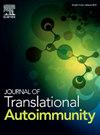Aberrant B cell receptor signaling responses in circulating double-negative 2 B cells from radiographic axial spondyloarthritis patients
IF 3.6
Q2 IMMUNOLOGY
引用次数: 0
Abstract
Objective
Radiographic axial spondyloarthritis (r-axSpA) is a chronic rheumatic disease in which innate immune cells and T cells are thought to play a major role. However, recent studies also hint at B cell involvement. Here, we performed an in-depth analysis on alterations within the B-cell compartment from r-axSpA patients.
Methods
We performed immune gene expression profiling on total peripheral blood B cells from 8 r-axSpA patients and 8 healthy controls (HCs). Next, we explored B cell subset distribution and B-cell receptor (BCR) signaling responses in circulating B cells from 28 r-axSpA patients and 15 HCs, by measuring spleen tyrosine kinase, phosphoinositide 3-kinase and extracellular signal regulated kinase 1/2 phosphorylation upon α-Ig stimulation using phosphoflow cytometry.
Results
Immune gene expression profiling indicated an elevated pathway score for BCR signaling in total B cells from r-axSpA patients compared with HCs. Flow cytometric analysis revealed an increase in frequency of both total and double-negative 2 (DN2) B cells in r-axSpA patients compared with HCs. In r-axSpA patients, DN2 B cells displayed an isotype shift towards IgA. Remarkably, where DN2 B cells from HCs were hyporesponsive, these cells displayed significant proximal BCR signaling responses in r-axSpA patients. Enhanced BCR signaling responses were also observed in the transitional and naïve B cell population from r-axSpA patients compared with HCs. The enhanced BCR signaling responses in DN2 B cells correlated with clinical disease parameters.
Conclusion
In r-axSpA patients, circulating DN2 B cells are expanded and, together with transitional and naïve B cells, display significantly enhanced BCR signaling responses upon stimulation. Together, our data suggest B cell involvement in the pathogenesis of r-axSpA.

轴性脊柱炎x线摄影患者循环双阴性B细胞异常B细胞受体信号反应
目的影像学中轴性脊柱炎(r-axSpA)是一种慢性风湿性疾病,先天免疫细胞和T细胞被认为在其中起主要作用。然而,最近的研究也暗示了B细胞的参与。在这里,我们对r-axSpA患者的b细胞室内的变化进行了深入分析。方法对8例r-axSpA患者和8例健康对照(hc)外周血总B细胞进行免疫基因表达谱分析。接下来,我们通过使用磷酸流式细胞术检测α-Ig刺激下脾脏酪氨酸激酶、磷酸肌肽3激酶和细胞外信号调节激酶1/2磷酸化,探讨了28例r-axSpA患者和15例hcc患者循环B细胞的B细胞亚群分布和B细胞受体(BCR)信号传导反应。结果免疫基因表达谱显示,与hc相比,r-axSpA患者总B细胞中BCR信号通路评分升高。流式细胞术分析显示,与hc相比,r-axSpA患者的总B细胞和双负2 (DN2) B细胞的频率均有所增加。在r-axSpA患者中,dn2b细胞表现出向IgA的同型转移。值得注意的是,当来自hc的DN2 B细胞反应低下时,这些细胞在r-axSpA患者中表现出显著的近端BCR信号反应。与hc相比,r-axSpA患者的过渡性和naïve B细胞群也观察到增强的BCR信号反应。DN2 B细胞BCR信号反应的增强与临床疾病参数相关。结论在r-axSpA患者中,循环DN2 B细胞扩增,并与过渡性和naïve B细胞一起,在刺激下表现出明显增强的BCR信号反应。总之,我们的数据表明B细胞参与了r-axSpA的发病机制。
本文章由计算机程序翻译,如有差异,请以英文原文为准。
求助全文
约1分钟内获得全文
求助全文
来源期刊

Journal of Translational Autoimmunity
Medicine-Immunology and Allergy
CiteScore
7.80
自引率
2.60%
发文量
33
审稿时长
55 days
 求助内容:
求助内容: 应助结果提醒方式:
应助结果提醒方式:


